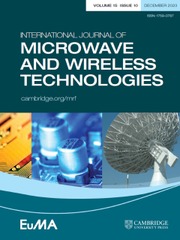No CrossRef data available.
Radiation pattern synthesis of smart fourth dimensional beamforming antenna arrays using optimally splitting pulses
Published online by Cambridge University Press: 01 July 2025
Abstract
Designing and developing smart antennas with adaptive radiation characteristics is an integral part for present-day communication systems. The versatile capabilities of Time-modulated fourth-dimensional (4D) antenna arrays can provide that crucial adaptability if properly designed. This work discusses an effective analysis of 4D antenna arrays to achieve less-attenuating radiation patterns with simultaneously suppressed sidelobe and sidebands. The 4D arrays offer an additional benefit over standard arrays in the sense that the requisite amplitude tapering to lower the undesired radiations can be accomplished by controlling only the switch ON times of the radiating elements instead of using attenuators. The idea of splitting pulses by keeping the total switch ON durations constant, is exploited here as an additional degree of freedom for beamforming of all the radiation patterns. The unwanted radiations in terms of sidelobes as well as sideband radiations (SRs) at the fundamental and harmonic frequencies, respectively are simultaneously minimized to improve the radiation efficiencies of the 4D array. To address the conflicting aims for the synthesis of radiation patterns, a wavelet-mutation based heuristic method is also proposed. The multi-objective problem in hand is modulated in to a single objective cost function as minimization problem. The proposed outcomes are reported and compared with other state of the art works related to the same domain. Furthermore, a detailed statistical analysis is also provided to identify the strengths and weaknesses of the proposed approach.
Information
- Type
- Research Paper
- Information
- International Journal of Microwave and Wireless Technologies , Volume 17 , Issue 3 , April 2025 , pp. 455 - 470
- Copyright
- © The Author(s), 2025. Published by Cambridge University Press in association with The European Microwave Association.


